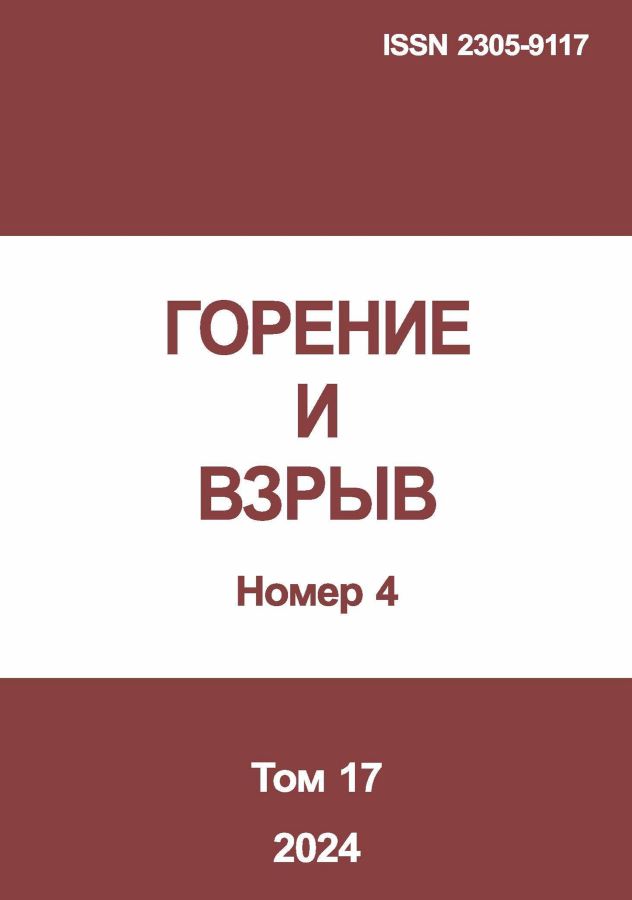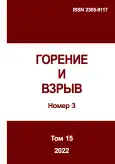Влияние объема реактора на автотермическую конверсию природного газа и аллотермическую газификацию органических отходов ультраперегретым паром
- Авторы: Фролов С.М.1,2, Сметанюк В.A.1, Садыков И.А.1, Силантьев А.С.1, Шамшин И.О.1, Аксёнов В.С.1,2, Авдеев К.А.1, Фролов Ф.С.1
-
Учреждения:
- Федеральный исследовательский центр химической физики им. Н. Н. Семёнова Российской академии наук
- Национальный исследовательский ядерный университет «МИФИ»
- Выпуск: Том 15, № 3 (2022)
- Страницы: 71-87
- Раздел: Статьи
- URL: https://journal-vniispk.ru/2305-9117/article/view/286557
- DOI: https://doi.org/10.30826/CE22150308
- EDN: https://elibrary.ru/JMZBKB
- ID: 286557
Цитировать
Аннотация
Технология импульсно-детонационной пушки (ИДП) применена для автотермической высокотемпературной конверсии природного газа и аллотермической бескислородной газификации жидких/твердых органических отходов ультраперегретым водяным паром (УПП) при атмосферном давлении с использованием двух проточных реакторов существенно разного объема: 100 и 40 л. Импульсно-детонационная пушка работала с частотой 1 Гц на смеси природного газа с кислородом. В качестве жидких и твердых органических отходов использовались отработанное машинное масло и древесные опилки влажностью от 10 до 30 %(вес.). Ожидалось, что уменьшение объема проточного реактора от 100 до 40 л, с одной стороны, не должно повлиять на конверсию природного газа, а с другой стороны, могло привести к повышению температуры газификации в проточном реакторе и, соответственно, к повышению качества получаемого синтез-газа (H2 + CO). Как и ожидалось, в ИДП была достигнута полная конверсия природного газа в синтез-газ с объемными отношениями Н2/СО и СО2/СО, равными 1,25 и 0,25, которые не зависели от объема реактора. Жидкие и твердые отходы конвертировались в проточных реакторах в газ, содержащий Н2, СО, СН4 и CO2. Установившиеся значения отношений H2/CO и CO2/CO в синтез-газе, полученном из отработанного машинного масла, составили 0,8 и 0,5 в 100-литровом реакторе и 0,9 и 0,2 в 40-литровом реакторе соответственно, что указывает на ожидаемое повышение качества синтез-газа. При этом максимальный массовый расход сырья в 40-литровом реакторе увеличился более чем в 4 раза по сравнению со 100-литровым реактором. Установившиеся значения отношений Н2/СО и СО2/СО в синтез-газе, полученном из порции древесных опилок фиксированной массы (2 кг), составили 0,5 и 0,8 для обоих реакторов, а время газификации в обоих реакторах составило около 5–7 мин. Показано, что измеренные объемные доли H2, СО и CO2 в синтез-газе, полученном как при автотермической высокотемпературной конверсии природного газа, так и при аллотермической бескислородной газификации жидких/твердых органических отходов в среде УПП при атмосферном давлении и Гц, почти не зависели от исходного сырья и объема реактора, что связано с высокими значениями локальной мгновенной температуры газификации.
Об авторах
Сергей Михайлович Фролов
Федеральный исследовательский центр химической физики им. Н. Н. Семёнова Российской академии наук; Национальный исследовательский ядерный университет «МИФИ»
Email: smfrol@chph.ras.ru
доктор физико-математических наук, заведующий отделом, заведующий лабораторией; ведущий научный сотрудник
Россия, Москва; МоскваВиктор Aлексеевич Сметанюк
Федеральный исследовательский центр химической физики им. Н. Н. Семёнова Российской академии наук
Email: smetanuk@chph.ras.ru
кандидат физико-математических наук, старший научный сотрудник
Россия, МоскваИльяс Александрович Садыков
Федеральный исследовательский центр химической физики им. Н. Н. Семёнова Российской академии наук
Email: ilsadykov@mail.ru
научный сотрудник
Россия, МоскваАнтон Сергеевич Силантьев
Федеральный исследовательский центр химической физики им. Н. Н. Семёнова Российской академии наук
Email: silantevu@mail.ru
инженер-исследователь
Россия, МоскваИгорь Олегович Шамшин
Федеральный исследовательский центр химической физики им. Н. Н. Семёнова Российской академии наук
Email: igor_shamshin@mail.ru
кандидат физико-математических наук, ведущий научный сотрудник
Россия, МоскваВиктор Серафимович Аксёнов
Федеральный исследовательский центр химической физики им. Н. Н. Семёнова Российской академии наук; Национальный исследовательский ядерный университет «МИФИ»
Email: v.aksenov@mail.ru
кандидат физико-математических наук, старший научный сотрудник; доцент
Россия, Москва; МоскваКонстатин Алексеевич Авдеев
Федеральный исследовательский центр химической физики им. Н. Н. Семёнова Российской академии наук
Email: kaavdeev@mail.ru
кандидат технических наук, ведущий научный сотрудник
Россия, МоскваФедор Сергеевич Фролов
Федеральный исследовательский центр химической физики им. Н. Н. Семёнова Российской академии наук
Автор, ответственный за переписку.
Email: f.frolov@chph.ru
кандидат физико-математических наук, старший научный сотрудник
Россия, МоскваСписок литературы
- Hu J., Shekhawat D. Direct natural gas conversion to value-added chemicals. — Boca Raton, FL, USA: CRC Press, 2022. 454 p.
- Base P. Biomass gasification and pyrolysis. Practical design. — Burlington, ON, USA: Academic Press, 2010. 376 p.
- Bain R. L., Broer K. Gasification // Thermochemical processing of biomass: Conversion into fuels, chemicals and power / Ed. R. C. Brown. — 1st ed. — John Wiley & Sons, 2011. P. 47–77.
- Frolov S. M. Organic waste gasification: A selective review // Fuels, 2021. Vol. 2. P. 556–651. doi: 10.3390/ fuels2040033.
- Фролов С. М. Газификация органических отходов ультраперегретым водяным паром и диоксидом углерода // Горение и взрыв, 2021. Т. 14. № 3. С. 74–97. doi: 10.30826/CE21140308.
- Portofino, S., Donatelli, A., Iovane, P., Innella C., Civi- ta R., Martino M., Matera D.A., Russo A., Cornacchia G., Galvagno S. Steam gasification of waste tyre: Influence of process temperature on yield and product composition // Waste Manage., 2013. Vol. 33. P. 672–678.
- Wilk V., Hofbauer H. Conversion of mixed plastic wastes in a dual fluidized bed steam gasifier // Fuel, 2013. Vol. 107. P. 787–799.
- Pilon G., Lavoie J.-M. Pyrolysis of switchgrass (Panicum virgatum L.) at low temperatures within N2 and CO2 environments: Product yield study // ACS Sustain. Chem. Eng., 2013. Vol. 1. P. 198–204.
- Sadhwani N., Adhikari S., Eden M. R. Biomass gasification using carbon dioxide: Effect of temperature, CO2/C ratio, and the study of reactions influencing the process // Ind. Eng. Chem. Res., 2016. Vol. 55. P. 2883–2891.
- Galvagno S., Casciaro G., Casu S., Martino M., Mingazzini C., Russo A., Portofino S. Steam gasification of tire waste,
- poplar, and refuse-derived fuel: A comparative analysis // Waste Manage., 2009. Vol. 29. P. 678–689.
- Soni C. G., Dalai A. K., Pugsley T., Fonstad T. Steam gasification of meat and bone meal in a two-stage fixed-bed reactor system // Asia-Pac. J. Chem. Eng., 2011. Vol. 6. P. 71–77.
- Eshun J., Wang L., Ansah E., Shahbazi A., Schimmel K., Kabadi V., Aravamudhan S. Characterization of the physicochemical and structural evolution of biomass particles during combined pyrolysis and CO2 gasification // J. Energy Inst., 2017. Vol. 92. P. 32–93.
- Minkova V., Marinov S. P., Zanzi R., Bjornbom E., Budinova T., Stefanova M., Lakov L. Thermochemical treatment of biomass in a flow of steam or in a mixture of steam and carbon dioxide // Fuel Process. Technol., 2000. Vol. 61. P. 45–52.
- Galvagno S., Casu S., Casciaro G., Martino M., Russo A., Portofino S. Steam gasification of refuse-derived fuel (RDF): Influence of process temperature on yield and product composition // Energ. Fuel., 2006. Vol. 20. P. 2284–2288.
- Umeki K., Yamamoto K., Namioka T., Yoshikawa K. High temperature steam-only gasification of woody biomass // Appl. Energ., 2010. Vol. 87. P. 791–798.
- Guizani C., Escudero Sanz F. J., Salvador S. Effects of CO2 on biomass fast pyrolysis: Reaction rate, gas yields and char reactive properties // Fuel, 2014. Vol. 116. P. 310–320.
- Hlina M., Hrabovsky M., Kavka T., Konrad M. Production of high quality syngas from argon/water plasma gasification of biomass and waste // Waste Manage., 2014. Vol. 34. P. 63–66.
- Billaud J., Valin S., Peyrot M., Salvador S. Influence of H2O, CO2 and O2 addition on biomass gasification in entrained flow reactor conditions: Experiments and modelling // Fuel, 2016. Vol. 166. P. 166–178.
- Agon N., Hrabovsky M., Chumak O., et al. Plasma gasification or refuse derived fuel in a single-stage system using different gasifying agents // Waste Manage., 2016. Vol. 47. P. 246–255.
- Hrabovsky M., Hlina M., Kopecky V., Maslani A., Zivny O., Krenek P., Hurba O. Steam plasma treatment of organic substances for hydrogen and syngas production // Plasma Chem. Plasma P., 2017. Vol. 37. P. 739–762.
- Wang M., Mao M., Zhang M., Wen G., Yang Q., Su B., Ren Q. Highly efficient treatment of textile dyeing sludge by CO2 thermal plasma gasification // Waste Manage., 2019. Vol. 90. P. 29–36.
- Shie J. L., Tsou F. J., Lin K. L., Chang C. Y. Bioenergy and products from thermal pyrolysis of rice straw using plasma torch // Bioresource Technol., 2010. Vol. 101. P. 761–768.
- Hrabovsky M. Plasma aided gasification of biomass, organic waste and plastics // 30th Conference (International) on Phenomena in Ionized Gas Proceedings. — Belfast, Northern Ireland, 2011. 4 p.
- Vecten S., Wilkinson M., Bimbo N., Dawson R., Herbert B. M. J. Hydrogen-rich syngas production from biomass in a steam microwave-induced plasma gasification reactor // Bioresource Technol., 2021. Vol. 337. P. 125324.
- Bebelin I. N., Volkov A. G., Gryaznov A. N., Malyshenko S. P. Development and research of an experimental hydrogen–oxygen steam generator with a capacity of 10 MW(t) // Therm. Eng., 1997. Vol. 8. P. 48–52.
- Lewis F. M. Generation of an ultra-superheated steam composition and gasification therewith. U.S. Patent US20030233788A1, 2007.
- Сариев В. Н., Веретенников В. А., Трояченко В. В. Система комплексной безотходной переработки твердых бытовых и промышленных отходов. Патент РФ 2648737 от 28.03.2018. Приоритет 12.08.2016.
- Pierce T. H., Afify E. M., Zickefoose R. T. Detonation-induced coal gasification. — Raleigh, NC, USA: Department of Mechanical and Aerospace Engineering, North Carolina State University, 1979. Final Report No. DOE/ET/10451-T1.
- Pierce T. H. Detonation-induced coal gasification // Int. J. Energ. Res., 1987. Vol. 11. No. 2. P. 203–231.
- Hunter L. G. Pulse detonation device for coal gasification. US Patent 5,672,184, 30.09.1997.
- Frolov S. M., Smetanyuk V. A., Sadykov I. A., Silantiev A. S., Shamshin I. O., Aksenov V. S., Avdeev K. A., Frolov F. S. Natural gas conversion and liquid/solid organic waste gasification by ultra-superheated steam // Energies, 2022. Т. 15. P. 3616. doi: 10.3390/en15103616.
- Фролов С. М., Сметанюк В. А., Авдеев К. А., Набатни- ков С. А. Способ получения сильно перегретого пара и устройство детонационного парогенератора (варианты). Патент РФ № 2686138 от 24.04.2019. Приоритет от 26.02.2018.
- Фролов С. М., Сметанюк В. А., Набатников С. А. Способ газификации угля в сильно перегретом водяном паре и устройство для его осуществления. Патент Российской Федерации № 2683751 от 01.04.2019. Приоритет от 24.05.2018.
- Фролов С. М., Набатников С. А., Диесперов К. В., Ачильдиев Е. Р. Способ обеззараживания летучей золы, образующейся при сжигании отходов, и устройство для его осуществления. Патент РФ № 2739241 от 22.12.2020. Приоритет от 11.06.2020.
- Фролов С. М., Сметанюк В. А., Шамшин И. О., Коваль А. С., Фролов Ф. С., Набатников С. А. Получение сильно перегретого водяного пара с помощью циклической детонации тройной газовой смеси «пропан – кислород – водяной пар» // Горение и взрыв, 2019. Т. 12. № 4. С. 95–103, doi: 10.30826/CE19120410.
- Фролов С. М., Сметанюк В. А., Сергеев С. С. Реактор для газификации отходов сильно перегретым водяным паром // Докл. Акад. наук, 2020. Т. 495. С. 71–76. doi: 10.31857/S2686953520060151.
- Frolov S. M., Smetanyuk V. A., Shamshin I. O., Sadykov I. A., Koval’ A. S., Frolov F. S. Production of highly superheated steam by cyclic detonations of propane and methane–steam mixtures with oxygen for waste gasification // Appl. Therm. Eng., 2021. Vol. 183. No. 1. P. 116195. doi: 10.1016/j.applthermaleng.2020.116195.
- Фролов С. М., Сметанюк В. А., Садыков И. А., Силантьев А. С., Аксёнов В. С., Шамшин И. О., Авдеев К. А., Фролов Ф. С. Автотермическая конверсия природного газа и аллотермическая газификация жидких и твердых органических отходов ультраперегретым водяным паром // Горение и взрыв, 2022. Т. 15. №2. С. 75–87. doi: 10.30826/CE22150207.
- Frolov S. M., Basevich V. Ya., Aksenov V. S., Polikhov S. A. Optimization study of spray detonation initiation by electric discharge // Shock Waves, 2005. Vol. 14. No. 3. P. 175–186. doi: 10.1007/s00193-005-0263-8.
- Ferreira S., Monteiro E., Brito P., Vilarinho C. A holistic review on biomass gasification modified equilibrium models // Energies, 2019. Vol. 12. P. 160.
Дополнительные файлы










